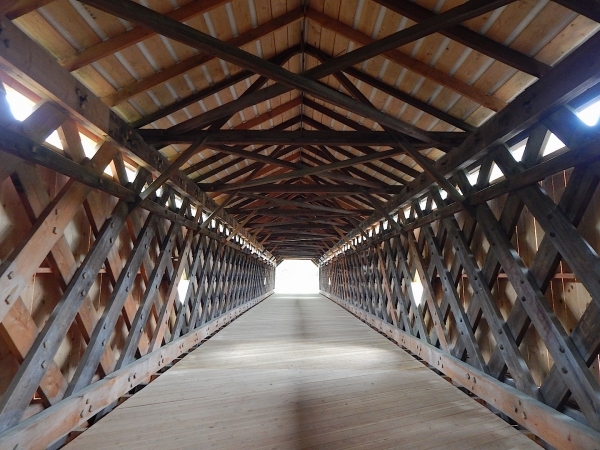TOWNSHEND — For the first time in more than five years, pedestrians can safely set foot on the historic Scott Covered Bridge.
A contractor has finished an extensive, $2.35 million rehabilitation of the wooden structure that stretches 277 feet over the West River in Townshend.
Despite its expense, the project was not aimed at restoring motorized traffic: Only pedestrians and bicycles are allowed on the bridge. But officials say they had no choice but to make a significant investment in the 147-year-old structure.
“It was a short time from falling into the drink,” said Mark Sargent, project manager for the Vermont Agency of Transportation.
Depending on who you ask, Scott Bridge may or may not be the longest covered bridge located entirely in Vermont. A recent engineering report gives it that honor, but some documents say the West Dummerston Covered Bridge - located a short drive south on Route 30 - is a few feet longer.
The two bridges also differ in how they are constructed and supported, and in how they are used. West Dummerston Covered Bridge is a relatively well-traveled link to and from Route 30, but the Scott Covered Bridge hasn't seen vehicular traffic in more than 60 years.
'Imminent failure'
Scott Bridge was closed entirely in February 2012 due to worsening structural problems. A report around that time found trusses that were in “imminent failure condition,” and the bridge's entrances were blocked by chain link fencing and “no trespassing” signs to keep pedestrians away.
A few years ago, VTrans came up with funding to renovate the state-owned bridge. No local money was required: The project was 81 percent federally funded, with the rest coming from the state.
The job, which began in late 2015, was awarded to Vernon-based Renaud Brothers Inc. The company has extensive covered-bridge experience, and Sargent said VTrans was “fortunate to get them.”
“I can't say enough ... [owner] Mike Renaud did a fabulous job,” Sargent said. “He straightened it out - there was a curve in it, and it was swaying downstream.”
The rehabilitation job included a new deck and a partial roof replacement. “We decided to replace all of the sheathing for the roof,” Sargent said. “We didn't replace all of the rafters, but we replaced some of them.”
The bridge is considered unusual not just for its length, but also because it features two different types of truss designs - town lattice and king post. Crews found more problems than had been expected in the king post section.
“It was just all rotten,” Sargent said. “Carpenter ants had gotten in there and wreaked havoc.”
Renaud, who also has worked on the West Dummerston bridge, said Scott Bridge presented new challenges for his company. Workers had to spend time stabilizing the bridge before they could get down to the business of trying to repair the structure.
“It was just so much rot, trying to save what we could,” Renaud said. “In some instances, we were taking a piece and reusing it in another place where we could, just to retain it.”
“There was so much [structural] redundancy there,” he added. “It was holding itself together, but boy, it certainly wasn't sound.”
Finishing touches
The project officially was completed after a VTrans inspection on May 17. The finishing touches included application of an insecticide and a fire retardant, both of which are meant to extend the rehabilitated bridge's longevity.
“As long as no heavy vehicles go on it, it should last 50 years” before significant repairs are needed, Sargent said.
“I think what we've [still] got is a historic structure, and that's a good thing,” Sargent added. “We preserved it. Even though we did a lot of wood replacement on it, there are original timbers.”
Scott Bridge has been listed on the National Register of Historic Places since 1973.
The structure also bears personal history, as Renaud discovered during construction. In one instance, his crew gave a piece of wood to a passerby who mentioned that it bore the initials of several deceased family members.
“There were a lot of initials carved up there,” Renaud said. “There's a lot of history.”
Townshend Selectboard Chairwoman Kathy Hege takes a practical view of the bridge restoration project, wondering whether a defunct bus stop at the bridge might be viable again.
She's also happy to not have to worry about a deteriorated structure located just a few steps off Route 30.
“I'm glad the eyesore is gone, and I'm glad the potential danger is no longer there for the community,” Hege said.
